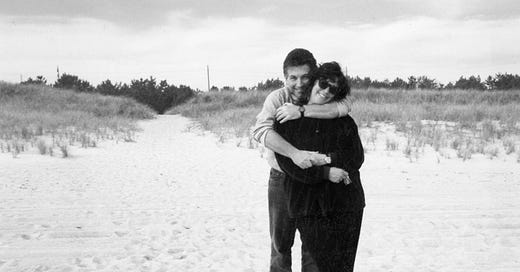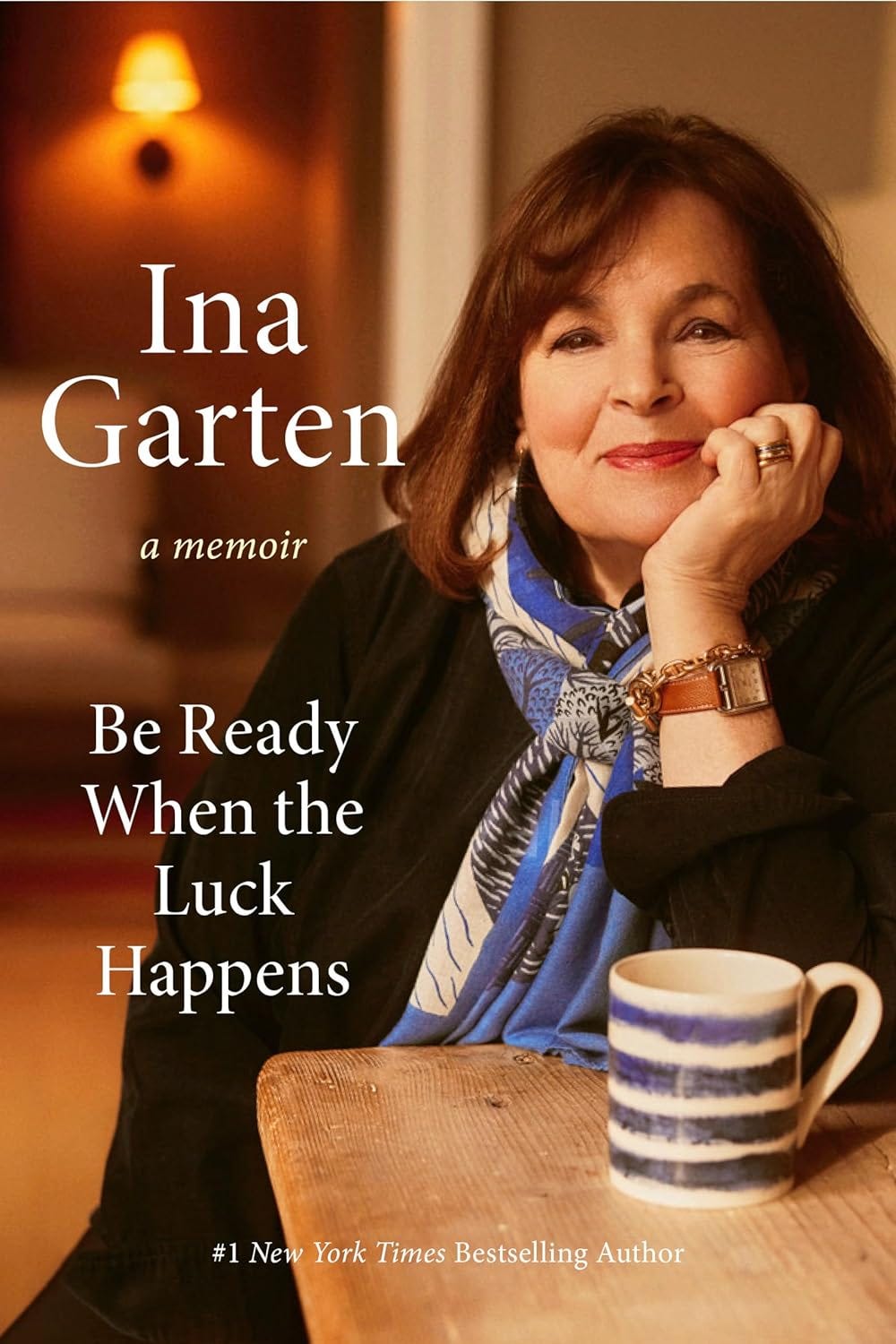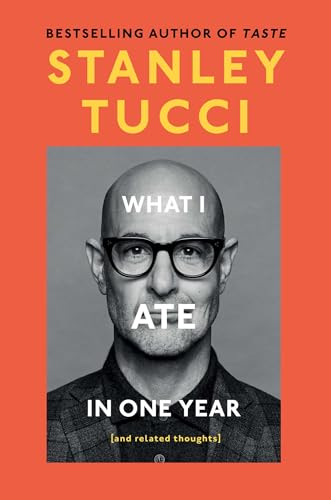Good afternoon! This past week, I read two very different nonfiction books — Ina Garten’s new memoir and a new nonfiction book about the Troubles in Northern Ireland. (I also finished Intermezzo by Sally Rooney last night, but honestly, I need a few days to process it.)
What I read:
Be Ready When the Luck Happens: A Memoir by Ina Garten
Ina Garten opens her memoir with two of the most important moments in her life—when she met Jeffrey Garten (now her husband) and when she responded to an advertisement in 1978 to buy Barefoot Contessa in the Hamptons (which she bought despite working at the White House at the time).
After reflecting on these two moments, Ina proceeds more or less chronologically through the major events of her life, starting with her lonely childhood. She grew up in Connecticut with a surgeon father, who was emotionally and physically abusive, and an almond mom. Her mother was a trained nutritionist who fed Ina and her brother meals like broiled chicken and steamed veggies — no carbohydrates, fat, or flavor.
Ina credits her strong relationship with Jeffrey with helping her overcome the alienation she felt during her childhood. She met Jeffrey when she was a high school senior, and he was a sophomore at Dartmouth. They married young. In the early years of their marriage, she learned how to fly a plane, camped with Jeffrey for months in Europe, and worked in the White House. But the real turning point in her life happened when she purchased the small specialty food shop Barefoot Contessa in Westhampton Beach.
I am a huge Ina fan and was excited to read this memoir when I heard it was coming out. Ina is sort of like the aunt everyone wishes they had — she is an amazing cook and host and has two gorgeous homes in the Hamptons and Paris. Jeffrey is a successful economist — he has worked in the White House, at Lehman Brothers, at Blackstone, and was the dean of the Yale School of Management.
Basically, their life does not seem real. But Ina’s honesty in Be Ready When the Luck Happens makes them relatable and gives this memoir real depth. She discusses how gender roles felt limiting to both her and Jeffrey. She also writes openly about their marital troubles — they separated for some time while she was running the Barefoot Contessa food shop. Ina writes, “There was the sense in our marriage that he was the parent, and I was the child. Then, when I went out in the world and started working, the dynamic shifted, and our roles became ‘man’ and ‘wife.’”
They eventually got back together and worked to grow together. She reflects on how:
when people are young, they often choose partners who embody qualities they wish they had themselves; however, as time passes, either those admired traits can become irritating and lead to distance in the relationship, or the couple can gradually grow closer by subtly incorporating those qualities into their own personalities, while still maintaining their individual identities.
Ina’s memoir is filled with life advice, like stressing the importance of honoring one’s instincts. She also writes in a warm, conversational tone. There are many exclamation points and rhetorical questions, like her signature phrase, “How easy is that?”
Overall, I really enjoyed reading this book and being in Ina’s head for a few days. I highly recommend it, especially if you are already an Ina fan.
Rating: 4/5
Genre: Memoirs (Chefs)
Notable prizes/book clubs/lists: The New York Times Best Books of 2024
Page count: 320 pages
Audio: 8 hours 47 minutes
Movie/TV pairings: Chef
Food pairings: Ina’s engagement roast chicken
Four Shots in the Night: A True Story of Spies, Murder, and Justice in Northern Ireland by Henry Hemming
Four Shots in the Night is set in Northern Ireland during the Time of Troubles in the 1980s. Hemming explores the role that intelligence and espionage played in the struggle between the British forces and the Irish Republican Army. One British intelligence officer estimated that one in three IRA leaders “was either close to a British agent” or was actually “being run by a handler or case officer.”
The book opens with a British agent approaching Frank Hegarty, a midlevel IRA member, in the early 1980s. Hegarty agreed to inform and eventually shared a key piece of intelligence with the British about three huge weapons shipments that the IRA received from Gaddafi-controlled Libya. The British authorities struggled with when to act on information shared by informants. Should they act on it and expose the informant? Or let their informant stay undercover?
In the end, the Irish police and British forces seized the arms haul in early 1986, and Hegarty fled to England. Hegarty was later lured back to Derry by Martin McGuinness (a top IRA leader) under the assurances that he would not be killed. Hegarty’s body was found later in 1986, in broad daylight, with duct tape over his eyes.
Hemming reconstructs his murder and explores the possibility that another British agent (Freddie Scappaticci, codenamed “Stakeknife”) pulled the trigger. Scappaticci was one of the leaders of the IRA’s “Nutting Squad,” which punished British informers, and was the highest-placed British spy in the IRA.
Four Shots in the Night is one of the best books I have read on the Troubles since Patrick Raden Keefe’s Say Nothing. It complements Say Nothing well. While Keefe focuses on Belfast and the gregarious IRA leader Gerry Adams, Hemming centers his novel on Derry and the feared IRA leader turned politician Martin McGuinness. This book reads like a thriller and touches on the complex legal landscape of this period—no formal war was declared. There were open criminal cases against members of the IRA and British armed forces, and the rules of conduct (like a British spy murdering another spy) were unclear.
I recommend this to anyone who likes true crime or wants something else to read after finishing Say Nothing.
Rating: 4.5/5
Genre: Nonfiction (Crime; Historical)
Page count: 368 pages
Audio: 9 hours 4 min
Movie/TV pairings: Say Nothing (coming out in a few weeks on Hulu)
Articles and podcasts I cannot stop thinking about:
Stanley “The Last Metrosexual” Tucci
This Celebrity Book Club podcast episode on Tucci’s new book, What I Ate in One Year, made me laugh.
“What ‘Chicken Shop Date’ Reminds Us About Flirting” by Gina Cherelus in The New York Times
Amelia Dimoldenberg finally interviewed actor Andrew Garfield on her YouTube series, Chicken Shop Date, where she goes on “first dates” with celebrities in fried chicken shops in London. The two have a lot of chemistry.
One of my friends said Halloween is “the new Met Gala.”
What I cooked:
I have been traveling a lot lately, so I repeated some staples — chopped broccoli salad and Thai-inspired meatball soup.










